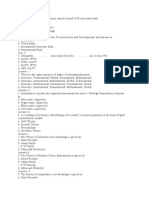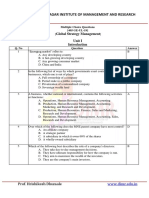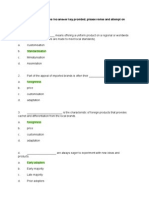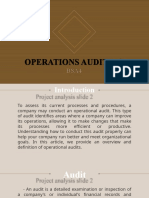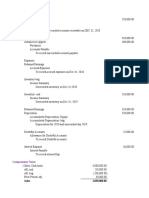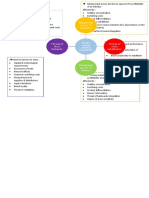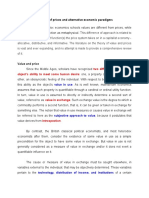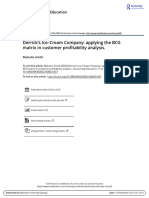67%(6)67% found this document useful (6 votes)
10K views30 Mcqs On Marketing
30 Mcqs On Marketing
Uploaded by
suresha90This document contains 30 multiple choice questions about international marketing concepts. The questions cover topics like marketing information sources, forms of foreign market involvement, types of distribution formats, international market segmentation, integrated marketing communications, and entry modes into foreign markets. An answer key is provided with the correct response for each question.
Copyright:
© All Rights Reserved
Available Formats
Download as PDF, TXT or read online from Scribd
30 Mcqs On Marketing
30 Mcqs On Marketing
Uploaded by
suresha9067%(6)67% found this document useful (6 votes)
10K views6 pagesThis document contains 30 multiple choice questions about international marketing concepts. The questions cover topics like marketing information sources, forms of foreign market involvement, types of distribution formats, international market segmentation, integrated marketing communications, and entry modes into foreign markets. An answer key is provided with the correct response for each question.
Original Title
30 Mcqs on Marketing
Copyright
© © All Rights Reserved
Available Formats
PDF, TXT or read online from Scribd
Share this document
Did you find this document useful?
Is this content inappropriate?
This document contains 30 multiple choice questions about international marketing concepts. The questions cover topics like marketing information sources, forms of foreign market involvement, types of distribution formats, international market segmentation, integrated marketing communications, and entry modes into foreign markets. An answer key is provided with the correct response for each question.
Copyright:
© All Rights Reserved
Available Formats
Download as PDF, TXT or read online from Scribd
Download as pdf or txt
67%(6)67% found this document useful (6 votes)
10K views6 pages30 Mcqs On Marketing
30 Mcqs On Marketing
Uploaded by
suresha90This document contains 30 multiple choice questions about international marketing concepts. The questions cover topics like marketing information sources, forms of foreign market involvement, types of distribution formats, international market segmentation, integrated marketing communications, and entry modes into foreign markets. An answer key is provided with the correct response for each question.
Copyright:
© All Rights Reserved
Available Formats
Download as PDF, TXT or read online from Scribd
Download as pdf or txt
You are on page 1of 6
Multiple Choice Questions
*Answer the questions by marking ( ) on appropriate answer.
1. Which of the following information forms available to the marketing manager can usually be
accessed more quickly and cheaply than other information sources?
a. Marketing intelligence
b. Marketing research
c. Customer profiles
d. Internal databases
2. All of the following are considered to be drawbacks of local marketing EXCEPT:
a. it can drive up manufacturing and marketing costs by reducing economies of scale.
b. it can create logistical problems when the company tries to meet varied requirements.
c. it can attract unwanted competition.
d. it can dilute the brand's overall image.
3. The biggest or greatest amount of involvement in a foreign market comes through which of the
following?
a. Exporting
b. Joint venturing
c. Licensing
d. Direct investment
4. ________________ has contractual authority to sell a manufacturer's entire output.
a. Selling agents
b. Rack jobbers
c. Manufacturer's agents
d. Purchasing agents
5. Sellers that handle their own exports are engaged in:
a. direct exporting.
b. indirect exporting.
c. licensing.
d. contract manufacturing.
6. Using a successful brand name to introduce additional items in a given product category under the
same brand name (such as new flavors, forms, colors, added ingredients, or package sizes) is
called a(n):
a. line extension.
b. brand extension.
c. multibranding.
d. new brands.
7. Google, Infoseek, and Excite are all called:
a. browsers.
b. Webcasters.
c. search engines.
d. software.
8. Wal-Mart owned Sam's club is an example of a retail form called a(n):
a. factory outlet.
b. super specialty store.
c. seconds store.
d. warehouse club.
9. ______________ is the general term for a buying and selling process that is supported by
electronic means.
a. Internet commerce
b. Web commerce
c. Computer commerce
d. Electronic commerce
10. ________________ consists of dividing a market into distinct groups of buyers on the basis of
needs, characteristics, or behavior who might require separate products or marketing mixes.
a. Product differentiation
b. Market segmentation
c. Market targeting
d. Market positioning
11. Many U.S. firms have sought relief from foreign competition by demanding protectionism policies
by the U.S. government. A better way for companies to compete is to expand into foreign markets
and:
a. lower prices.
b. increase promotion both at home and abroad.
c. continuously improve their products at home.
d. join into cartels at home.
12. Rolls Royce uses which of the following distribution formats?
a. Intensive distribution
b. Exclusive distribution
c. Selective distribution
d. Open distribution
13. When an importing country sets limits on the amount of goods it will accept in certain product
categories it is called a(n):
a. quota.
b. barrier.
c. tariff.
d. embargo.
14. A ________________ is a promotion strategy that calls for using the sales force and trade
promotion to move the product through channels.
a. push strategy
b. pull strategy
c. blocking strategy
d. integrated strategy
15. Which of the following is foreign owned (even though it is traditionally thought of as a U.S.
company)?
a. IBM
b. Xerox
c. Kodak
d. Universal Studios
16. A company is practicing ________________ if it focuses on sub segments with distinctive traits
that may seek a special combination of benefits.
a. micromarketing
b. niche marketing
c. mass marketing
d. segment marketing
17. _________________ is the concept under which a company carefully integrates and coordinates
its many communications channels to deliver a clear, consistent, and compelling message about
the organization and its products.
a. The promotion mix
b. Integrated international affairs
c. Integrated marketing communications
d. Integrated demand characteristics
18. A company faces several major decisions in international marketing. The first of these decisions is
often:
a. deciding whether to go international.
b. looking at the global marketing environment.
c. deciding which markets to enter.
d. deciding how to enter markets.
19. The American Marketing Association suggests a list of code of ethics. All of the following are
ethics suggested in the area of distribution EXCEPT:
a. not manipulating the availability of a product for purpose of exploitation.
b. not using coercion in the marketing channel.
c. using gray marketers whenever possible to save the consumer money.
d. not exerting undue influence over the reseller's choice to handle a product.
20. If a government uses barriers to foreign products such as biases against a foreign company's bids,
or product standards that go against a foreign company's product features, the government is using:
a. protectionism.
b. exchange controls.
c. exchange facilitators.
d. nontariff trade barriers.
21. Joining with foreign companies to produce or market products and services is called:
a. direct exporting.
b. indirect exporting.
c. licensing.
d. joint venturing.
22. Ultimately was replaced by the .on 1st Jan 1995
a. GATS, WTO
b. WTO, GATT
c. GATT, WTO
d. IMF, GATT
23. Which is the right sequence of stages of Internationalization?
a. Domestic, Transnational, Global, International, Multinational
b. Domestic, International, Multinational, Global, Transnational
c. Domestic, Multinational, International, Transnational, Global
d. Domestic, International, Transnational, Multinational, Global
24. Globalization refers to:
a. Lower incomes worldwide
b. Less foreign trade and investment
c. Global warming and their effects
d. A more integrated and interdependent world
25. Key controllable factors in global marketing are:
a. Government policy and legislation.
b. Social and technical changes.
c. Marketing activities and plans.
d. All of the above.
26. IBRD (International Bank for Reconstruction and Development) also known as
a. Exim Bank
b. World Bank
c. International Monetary fund
d. International Bank
27. The most common form of price discrimination in international trade is
a. Non-tariff barriers.
b. Voluntary Export Restraints.
c. Dumping.
d. Preferential trade arrangements.
e. None of the above
28. VAT is a/an
a. Income tax
b. Sales Tax
c. Custom Duty
d. Travel Tax
29. International dimension of marketing includes
a. Domestic marketing
b. Foreign marketing
c. International trade
d. All
30. A branch and subsidiary are
a. Different to each other
b. Similar to each other
c. All
d. None
Answer Key
Multiple Choice Questions
International Marketing (MBA-IB-01)
SET 2
1. d
2. c
3. d
4. a
5. a
6. a
7. c
8. d
9. d
10. b
11. c
12. b
13. a
14. a
15. d
16. b
17. c
18. b
19. c
20. d
21. d
22. c
23. b
24. d
25. c
26. b
27. c
28. b
29. d
30. a
You might also like
- List of Taxpayers With Turnover Between 20 Cr. and 50 Cr. Who Are Enabled For E-Invoice W.E.F. 01.04.2022Document228 pagesList of Taxpayers With Turnover Between 20 Cr. and 50 Cr. Who Are Enabled For E-Invoice W.E.F. 01.04.2022Kiran Goud100% (1)
- Marketing Management MCQS: Chapter 1: The Nature of MarketingDocument98 pagesMarketing Management MCQS: Chapter 1: The Nature of MarketingThe masked football punditNo ratings yet
- PDFDocument28 pagesPDFdaryll0% (1)
- 5100 MTDocument144 pages5100 MTlgoNo ratings yet
- MCQ - CONSUMER BEHAVIOUR - With Answer Keys PDFDocument10 pagesMCQ - CONSUMER BEHAVIOUR - With Answer Keys PDFVijyata Singh100% (1)
- International Marketing MCQSDocument25 pagesInternational Marketing MCQSprasadkulkarnigit53% (19)
- Marketing Strategy MCQSDocument19 pagesMarketing Strategy MCQSketkiNo ratings yet
- Services Marketing MCQ With Answers (Updated 2021)Document5 pagesServices Marketing MCQ With Answers (Updated 2021)samaya pyp100% (1)
- Marketing Management MCQsDocument6 pagesMarketing Management MCQsMOHAMMAD NADEEM100% (1)
- Examples of Examination Questions: Multiple ChoiceDocument12 pagesExamples of Examination Questions: Multiple ChoiceSreekanth NagloorNo ratings yet
- TM Forum Poster Business Process Framework Frameworx 13.5Document1 pageTM Forum Poster Business Process Framework Frameworx 13.5Vlatko Kotevski100% (2)
- Mcq-International Marketing-PaperDocument5 pagesMcq-International Marketing-PaperAnil Kumar100% (1)
- MULTIPLEDocument27 pagesMULTIPLETage Nobin100% (1)
- MCQ On Marketing ManagementDocument39 pagesMCQ On Marketing ManagementtusharNo ratings yet
- The Hindu College - Mba Machilipatnam: Marketing SpecializationDocument29 pagesThe Hindu College - Mba Machilipatnam: Marketing SpecializationSabri Binkasim100% (1)
- Multiple Choice Questions - V Commerce - V: Unit 1Document18 pagesMultiple Choice Questions - V Commerce - V: Unit 1Hari Krishna ChalwadiNo ratings yet
- PDF International Marketing MCQ DDDocument29 pagesPDF International Marketing MCQ DDGaurav SonkeshariyaNo ratings yet
- International MarketingDocument7 pagesInternational MarketingAkshay jireNo ratings yet
- MCQ AmDocument3 pagesMCQ AmAaruni BattaNo ratings yet
- Answer: D) All of The Above: B) Digital Marketing Cannot Be Done OfflineDocument29 pagesAnswer: D) All of The Above: B) Digital Marketing Cannot Be Done Offlinejayant bansal100% (1)
- Customer Relationship Management PDFDocument22 pagesCustomer Relationship Management PDFVeeramani Iyer100% (2)
- MCQ's Unit-II: Organizing The Sales Force: D. Needs AssessmentDocument6 pagesMCQ's Unit-II: Organizing The Sales Force: D. Needs AssessmentVishal SoodanNo ratings yet
- The Promotion MixDocument5 pagesThe Promotion Mixkeshavrathi183% (6)
- Business Environment Solved MCQs (Set-1)Document6 pagesBusiness Environment Solved MCQs (Set-1)Shree Prakash GuptaNo ratings yet
- QB Consumer BehaviourDocument28 pagesQB Consumer BehaviourSatyender Kumar Jain100% (2)
- BBA 505B Sales-MAnagementDocument62 pagesBBA 505B Sales-MAnagementNithin RajuNo ratings yet
- Mcqs of Stretagic Marketing 1Document15 pagesMcqs of Stretagic Marketing 1FaiEz AmEen KhanNo ratings yet
- MCQ With Answers - CRMDocument8 pagesMCQ With Answers - CRMdr bharath k50% (2)
- IB MCQs PDFDocument23 pagesIB MCQs PDFAnkush GargNo ratings yet
- MCQ Brand MarketingDocument15 pagesMCQ Brand MarketingDr. Shailendra Kumar SrivastavaNo ratings yet
- Principles of Marketing - MGT301 Solved Mcqs PDFDocument51 pagesPrinciples of Marketing - MGT301 Solved Mcqs PDFsehar Shah nawaz100% (1)
- Integrated Marketing CommunicationDocument22 pagesIntegrated Marketing CommunicationMallikarjun Reddy Avisala100% (1)
- DBM MCQ UpdatedDocument43 pagesDBM MCQ UpdatedasimNo ratings yet
- Customer Relationship Management (CRM) Solved MCQs (Set-1)Document6 pagesCustomer Relationship Management (CRM) Solved MCQs (Set-1)Dương Huy Chương ĐặngNo ratings yet
- Marketing Fundamental MCQDocument9 pagesMarketing Fundamental MCQSachin Wankhede0% (1)
- CRM Unit 1 PT 2Document5 pagesCRM Unit 1 PT 2Nihal AnshuNo ratings yet
- Sales Management MCQ CHP 01 and 02Document4 pagesSales Management MCQ CHP 01 and 02jayant bansalNo ratings yet
- MCQ - International Business ManagementDocument31 pagesMCQ - International Business ManagementShaukatali ShaikhNo ratings yet
- Advertising Management BBA301Document22 pagesAdvertising Management BBA301manishNo ratings yet
- CRM Unit 1 PT 1Document6 pagesCRM Unit 1 PT 1Nihal AnshuNo ratings yet
- International Business MCQDocument17 pagesInternational Business MCQyewihNo ratings yet
- Business MCQDocument21 pagesBusiness MCQRajat JazziNo ratings yet
- Entrepreneurship Development Mcq.Document40 pagesEntrepreneurship Development Mcq.Sur AJ100% (1)
- Consumer BehaviourDocument22 pagesConsumer BehaviourShailja VaidNo ratings yet
- Final MCQ For Conumer BehaviorDocument25 pagesFinal MCQ For Conumer BehaviorSrivatsav Sri100% (1)
- Business Environment Q & ADocument16 pagesBusiness Environment Q & ASadaf NazneenNo ratings yet
- MCQ Business EnvironmentDocument14 pagesMCQ Business EnvironmentRohan Roy100% (1)
- MCQ's Sales and Distribution Management: ConsumersDocument6 pagesMCQ's Sales and Distribution Management: Consumersjaitripathi26100% (1)
- Chapter 1 Marketing: Creating and Capturing Customer ValueDocument21 pagesChapter 1 Marketing: Creating and Capturing Customer ValueAbdullah JuttNo ratings yet
- Consumer Behaviour: Choose The Correct Answer From The BracketDocument29 pagesConsumer Behaviour: Choose The Correct Answer From The BracketKuhu MiglaniNo ratings yet
- Marketing Management Test (Audry)Document9 pagesMarketing Management Test (Audry)Chong Kai MingNo ratings yet
- Business Environment MCQsDocument17 pagesBusiness Environment MCQsDrs InresearchNo ratings yet
- Service MarketingDocument35 pagesService MarketingDipak sagathiyaNo ratings yet
- DIMR MCQ 405 Global Strategy ManagementDocument37 pagesDIMR MCQ 405 Global Strategy ManagementAbhishek A. NadgireNo ratings yet
- MCQ Bom 106Document16 pagesMCQ Bom 106Shweta SinghNo ratings yet
- Multiple Choice Questions On International Marketing 2Document5 pagesMultiple Choice Questions On International Marketing 2frmchnn75% (12)
- 5 6118294360418157486Document17 pages5 6118294360418157486Ashish patilNo ratings yet
- Kotler-Chapter-10-MCQ Kotler-Chapter-10-MCQDocument23 pagesKotler-Chapter-10-MCQ Kotler-Chapter-10-MCQHamza AsifNo ratings yet
- Answer The Questions by Marking On Appropriate AnswerDocument6 pagesAnswer The Questions by Marking On Appropriate AnswerRozy SinghNo ratings yet
- Choice QuestionsDocument13 pagesChoice Questionsjemalkamil2No ratings yet
- International Marketing V1ADocument10 pagesInternational Marketing V1Asolvedcare100% (1)
- Gmsamplemcquestions 110325104823 Phpapp01Document12 pagesGmsamplemcquestions 110325104823 Phpapp01Jasmine Liew0% (1)
- Operations AuditingDocument16 pagesOperations AuditingElla AballeNo ratings yet
- Audit of Shareholders EquityDocument2 pagesAudit of Shareholders EquityGwyneth TorrefloresNo ratings yet
- XI Accounts Case Based QuestionsDocument10 pagesXI Accounts Case Based QuestionsyuvisinghmankooNo ratings yet
- Beginner's Guide To Digital Marketing For Southeast Asia - Main Channels (Part I)Document262 pagesBeginner's Guide To Digital Marketing For Southeast Asia - Main Channels (Part I)Kamila KusmeinarNo ratings yet
- BB 2 Futures & Options Hull Chap 1 & 2Document32 pagesBB 2 Futures & Options Hull Chap 1 & 2winfldNo ratings yet
- Operations Management: - Location StrategiesDocument41 pagesOperations Management: - Location Strategiesnikeeta1No ratings yet
- Financial Accounting 1 - Theory QuestionsDocument7 pagesFinancial Accounting 1 - Theory Questionsstellajayakumar13305No ratings yet
- Problems and Questions - 3Document6 pagesProblems and Questions - 3mashta04No ratings yet
- Function and Role of Financial System (Chapter-1)Document44 pagesFunction and Role of Financial System (Chapter-1)Kishor Mahmud83% (6)
- Customer RelationsDocument20 pagesCustomer RelationsasgharNo ratings yet
- Chapter 14Document6 pagesChapter 14Mychie Lynne MayugaNo ratings yet
- 10 PriorPeriodErrorsDocument9 pages10 PriorPeriodErrorsstudent100% (3)
- MC - Internal AuditDocument12 pagesMC - Internal AuditMegawati MediyaniNo ratings yet
- PE 2023 Lecture 3Document32 pagesPE 2023 Lecture 3Kiara RamdhawNo ratings yet
- Bargaining Power of Suppliers: Rivalry Among Existing CompetitorsDocument1 pageBargaining Power of Suppliers: Rivalry Among Existing CompetitorsrrttrrthaaaaaNo ratings yet
- Actual Cost & Transfer Price-4Document64 pagesActual Cost & Transfer Price-4Brian3911100% (1)
- CORPORATE GOVERNANCE (Final)Document57 pagesCORPORATE GOVERNANCE (Final)anhbui.31211023068No ratings yet
- 0309 BdmsDocument4 pages0309 BdmscoolartncraftsNo ratings yet
- Garrison FSA Solman PDFDocument39 pagesGarrison FSA Solman PDFGeraldo Mejillano100% (1)
- Deregulated Power System: Presented byDocument21 pagesDeregulated Power System: Presented bySurya TejaNo ratings yet
- 4.1 Theories of Prices and Alternative Economic ParadigmsDocument3 pages4.1 Theories of Prices and Alternative Economic ParadigmsFebbyNo ratings yet
- Burberry Aduit Final DraftDocument15 pagesBurberry Aduit Final Draftapi-275576169No ratings yet
- Derrick's Ice-Cream Company: Applying The BCG Matrix in Customer Profitability AnalysisDocument12 pagesDerrick's Ice-Cream Company: Applying The BCG Matrix in Customer Profitability Analysisihsan nasihinNo ratings yet
- Adjusting Entries Quiz 2Document25 pagesAdjusting Entries Quiz 2Chris MartinezNo ratings yet
- A Study On Working Capital Management at CoffeeDocument70 pagesA Study On Working Capital Management at CoffeePunitha KumaravelNo ratings yet
- Solomon TesfayeDocument111 pagesSolomon TesfayehassenapdunasirNo ratings yet
- Risk & Return NCFMDocument41 pagesRisk & Return NCFMworld4meNo ratings yet









































